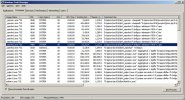I've been scratching my head and trying to read whatever I can find... I think there's a rogue transaction at the root, There is only Epicor code updating the database, all odbc clients are in read uncommitted, so there's no transactions from users.. I do not believe it to be a database tuning prob...If anyone has ideas, I'd appreciate it. (There's a very high bridge nearby...but I'd probably just end up breaking my neck ;-)
I have a 10.1B SP3 HF33 database F:\mfgsys, on a raid 0 pair of velociraptor drives, completely isolated... running windows 2008 R2, hex core, 8G box. It's generally very snappy and performance is great, any normal query executes in < 0.2 sec...and when all is well my b1 file is about 20-25% of my d1,(I've been experimenting with bi cluster and block sizes with no improvement)...about every 3-5 days, a _proapsv.exe begins to run continously and the b1 file will grow indefinitely until I kill the offending _proapsv.exe process... shutdown... truncate, which can take an hour if I don't get to quickly and the b1 file continues to grow to about 150% of its size when I shut down, truncating a 50G b1 is not a pleasant on a production system. I got so desperate I wrote a small script to monitor the b1 file and email me if it grows even 1 byte ).
).
Here's some details...

I have a 10.1B SP3 HF33 database F:\mfgsys, on a raid 0 pair of velociraptor drives, completely isolated... running windows 2008 R2, hex core, 8G box. It's generally very snappy and performance is great, any normal query executes in < 0.2 sec...and when all is well my b1 file is about 20-25% of my d1,(I've been experimenting with bi cluster and block sizes with no improvement)...about every 3-5 days, a _proapsv.exe begins to run continously and the b1 file will grow indefinitely until I kill the offending _proapsv.exe process... shutdown... truncate, which can take an hour if I don't get to quickly and the b1 file continues to grow to about 150% of its size when I shut down, truncating a 50G b1 is not a pleasant on a production system. I got so desperate I wrote a small script to monitor the b1 file and email me if it grows even 1 byte
 ).
).Here's some details...
| Directory of F:\ 04/20/2012 09:58 AM <DIR> archive 04/13/2012 07:52 AM 53 backup.bat 05/01/2012 01:10 PM 268,697,600 mfgsys.b1 05/01/2012 01:10 PM 1,222,770,688 mfgsys.d1 05/01/2012 01:06 PM 32,768 mfgsys.db 05/01/2012 01:46 PM 49,832 mfgsys.lg 05/02/2012 08:00 AM 182,858 mfgsys.lic 05/01/2012 01:10 PM 38 mfgsys.lk 10/02/2011 10:32 PM 81 mfgsys.st 03/27/2012 08:15 AM 1,050 startsvrs803.cmd 04/17/2012 10:53 AM 39 stats.bat 03/19/2012 12:23 PM 1,066 stopsvrs803.bat 11 File(s) 1,491,736,073 bytes 1 Dir(s) 1,198,398,373,888 bytes free |
|

